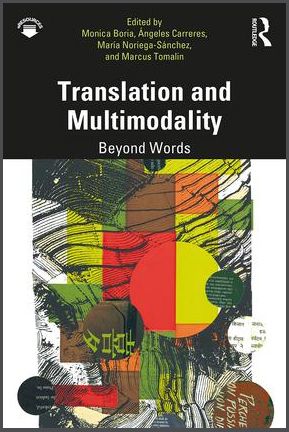Edited by Monica Boria, Ángeles Carreres, Maria Noriega-Sánchez and Marcus Tomalin,Translation and Multimodality: Beyond Words (Routledge, November 2019) is one of the first books to explore how translation needs to be redefined and reconfigured in contexts where multiple modes of communication, such as writing, images, gesture, and music, occur simultaneously. Bringing together world-leading experts in translation theory and multimodality, each chapter explores important interconnections among these related, yet distinct, disciplines.

Q. Ángeles, Marcus, María, Monica, what is your book Translation and Multimodality: Beyond Words about? What drew you to the subject?
Our book is an edited volume that explores how translation needs to be redefined in contexts where multiple modes of communication are involved simultaneously (e.g. words, images, movement, gesture, music). As communication becomes ever more multimodal, there is an increasingly urgent need to reconsider how this changes the way we understand and conceptualise translation. Our CRASSH-based research group Cambridge Conversations in Translation (2015-2018) became interested in this topic in 2015. We subsequently organised panel discussions and workshops concerning translating audiovisual materials, translating music, and translating for the stage. When discussing these topics, we realised that the existing theoretical frameworks for translation were inadequate for analysing multimodal transfers of meaning. We wanted to explore how translation theory could and should be modified, and to probe the limits of what can legitimately be called ‘translation’. This led us to organise a one-day conference on translation and multimodality in May 2017, which focused on the fields of dance, the visual arts, e-literature, and word-based art. We then organised a two-day conference on the subject in July 2018, and that event was pivotal in shaping our book.
Q. Around which themes did you decide to structure the book, and to what end?
The book addresses a range of important interconnections between the two related, yet distinct, fields of multimodality and translation. Each chapter explores multimodal translation from a different disciplinary perspective. Together they offer fascinating insights into the field, as well as being testimony to the very significant potential for cross-disciplinary dialogue in this area. Gunther Kress offers an authoritative assessment that draws upon multimodality studies; Klaus Kaindl sets out a theoretical framework for a multimodal conception of translation; Luis Pérez González analyses multimodal subtitling practices in user-generated products/videos; Elisabetta Adami and Sara Ramos Pinto put forward a joint semiotic and translation research agenda; Matthew Reynolds and Marcus Tomalin both explore multimodal literary translation; Helen Julia Minors explores translation in music-dance works; and, finally, Tamarin Norwood offers an experimental chapter which discusses, as well as performs, the interplay between writing and drawing.
Q. Who did you have in mind when you wrote the book? Would it make sense to someone outside your field?
Our book is mainly aimed at students and researchers in translation studies, multimodality studies, linguistics, and communication studies, but students from fields such as music, art, and literary studies will undoubtedly find relevant chapters in this volume. It may also appeal to non-specialist readers who happen to be interested either in recent thinking about the theory and practice of translation, or who want to make sense of our increasingly multimodal societies.
Q. In your view, what is the book’s main contribution to the field?
The volume constitutes one of the first book-length studies on the subject, and it brings together world-leading experts in translation theory and multimodality. We have endeavoured to encourage the re-theorisation of translation studies along multimodal lines, while also inviting multimodality scholars to engage more substantially with the theory and practice of translation. We hope our book will foster a deeper exchange between these two disciplines, outlining directions for future research that will require stronger and wider-ranging interdisciplinary collaboration.
Q. Can you contextualise the cover image and explain why you chose it?
The image is a reproduction of a mixed-media work by the transnational artist Gurpran Rau. She has ‘translated’ her memories of the countries she has lived in through images, colour and words, and we thought this was a fitting visual representation for our book. The cover image was also part of our branding for the CRASSH-based research group, from which the book emerged. It seemed appropriate to maintain that visual link. We are preparing for a book launch at CRASSH in January 2020, and we hope to welcome the artist, along with the contributors to the volume. Anyone interested in translation and/or multimodality will be very welcome to join us!
• The research group Cambridge Conversations in Translation organised workshops, panel discussions, and a conference on the theme of translation. Its aim was to provide a forum at Cambridge where practitioners and scholars from fields as diverse as literary studies, linguistics, theology, history, music, philosophy, and so on, could meet and exchange ideas about the theory and practice of translation. The group played a particularly valuable role, since Cambridge is one of the few world-leading universities that has no institutional infrastructure for studying translation as an independent field (e.g., it is impossible to study for a Master’s degree in Translation Studies at Cambridge). Consequently, the series was very popular and successful, and we are grateful to CRASSH for its continued support over a three-year period.
• Monica Boria is Affiliated Lecturer in the Department of Italian at the University of Cambridge and a translator. Ángeles Carreres is a Senior Language Teaching Officer in the Department of Spanish and Portuguese at the University of Cambridge. María Noriega-Sánchez is Senior Language Teaching Officer in Spanish at the University of Cambridge, and a Fellow in Modern Languages at Sidney Sussex College. Marcus Tomalin is a Fellow at Trinity Hall College, Cambridge.

